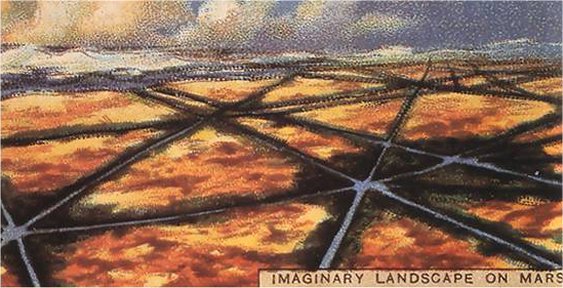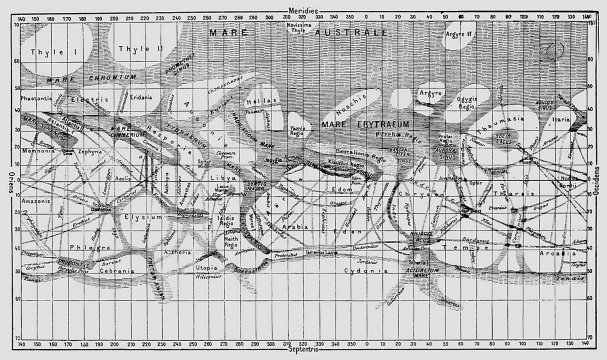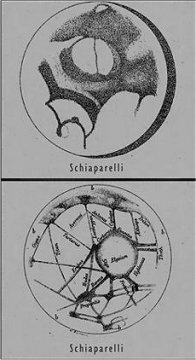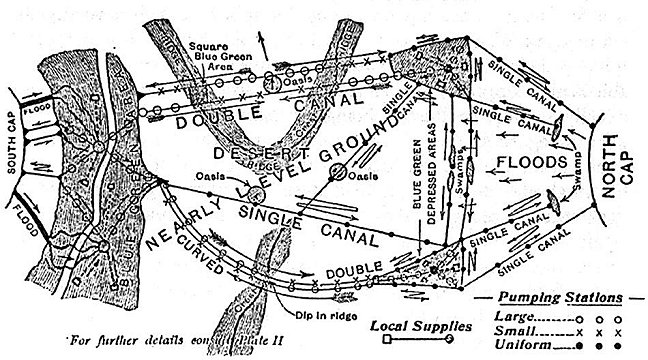THE SEVEN WONDERS OF BARSOOM SERIES
THE LIFE-SAVING PUMPING STATIONS OF MARS:
The First Wonder of Barsoom
by
Woodrow Edgar Nichols, Jr.

INTRODUCTION

The Mars of ERB is a dying planet. When the five oceans
of Barsoom evaporated, life became impossible and only the innovations
of Martian scientists made it possible for life to continue. In light of
global warming and climate change on today’s Earth, the story of ERB's
Barsoom is more relevant than ever. How do intelligent beings cope when
their extinction is imminent?
When ERB started his Martian series of books in 1911,
the idea of Earth sharing the same fate someday must have been viewed as
pure fantasy. Then came the atom bomb and evidence of collisions with meteors
and comets, an idea first mocked as insane when proposed by Immanuel Velikovsky
in his controversial Worlds
in Collision published in 1950.
Yes, the world has changed and ERB's Martian series is
just as fun to read today as it was to the less scientific sophisticated
folk of his day. As we bring the Seven Wonders of Barsoom series
to a close, it is no wonder that the Life-Saving Pumping Stations
should receive the premier spot.

DATA

A. The Water Pumping Stations
of Barsoom.
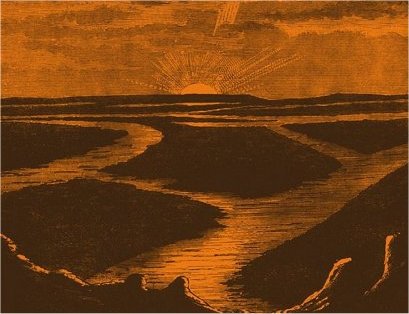
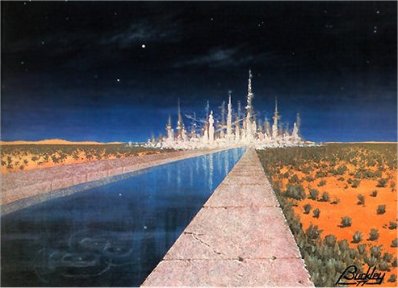
Canals of Mars from Camille
Flammarion and a more recent artist interpretation - ERBzine
Mars Fever
Life is impossible without water and the Barsoomians have
the black race to thank for making over half of this precious resource
possible. Carter, like most of the inhabitants of the planet, had no idea
of the role of the black race as the providers for most of the water in
its canals that made the Red Martian civilizations possible, but that view
is corrected by the black Dator Xodar in The Gods of Mars as he
explains the marvels of Omean to Carter:
“Xodar was at my side as
I stood looking out over the ship's rail.
“‘What course?’ I asked him.
“‘A little west of south,’ he replied.
“You will see the Otz Valley directly. We shall skirt it for a few hundred
miles.”
“‘The Otz Valley!’ I exclaimed;
‘but, man, is not there where lie the domains of the therns from which
I but just escaped?’
“‘Yes,’ answered Xodar. ‘You crossed
this ice field last night in the long chase that you led us. The Otz Valley
lies in a mighty depression at the south pole. It is sunk thousands of
feet below the level of the surrounding country, like a great round bowl.
A hundred miles from its northern boundary rise the Otz Mountains which
circle the inner Valley of Dor, in the exact center of which lies the Lost
Sea of Korus. On the shore of this sea stands the Golden Temple of Issus
in the Land of the First Born. It is there that we are bound.’
“As I looked I commenced to realize
why it was that in all the ages only one had escaped from the Valley Dor.
My only wonder was that even the one had been successful. To cross this
frozen, wind-swept waste of bleak ice alone and on foot would be impossible.
“‘Only by air boat could the journey
be made,’ I finished aloud.
“‘It was thus that one did escape
the therns in bygone times; but none has ever escaped the First Born,’
said Xodar, with a touch of pride in his voice.
“We had now reached the southernmost
extremity of the great ice barrier. It ended abruptly in a sheer wall thousands
of feet high at the base of which stretched a level valley, broken here
and there by low rolling hills and little clumps of forest, and with tiny
rivers formed by the melting of the ice barrier at its base.
“Once we passed far above what seemed
to be a deep canyon-like rift stretching from the ice wall on the north
across the valley as far as the eye could reach. ‘That is the bed of the
River Iss,’ said Xodar. ‘It runs far beneath the ice field, and below the
level of the Valley Otz, but its canyon is open here.’” (GM/8.)
Many artistic depictions of this area appear in wonderful
maps that can be viewed at ERBzine
#2807. They then view a village in the valley which Xodar explains
is a village of lost souls, neutral ground where pilgrims to the Valley
Dor reside who have lost their nerve and fearful of the fate they face
if they return to their homes. Other inhabitants are slaves who have escaped
from the therns.
“Now we swung a little
north of west, leaving the valley of lost souls, and shortly I discerned
over our starboard bow what appeared to be a black mountain rising from
the desolate waste of ice. It was not high and seemed to have a flat top....
“As we neared the dark, truncated
cone the vessel’s speed was diminished until we barely moved. Then we topped
the crest of the mountain and below us I saw yawning the mouth of a huge
circular well, the bottom of which was lost in inky blackness.
“The diameter of this enormous pit
was fully a thousand feet. The walls were smooth and appeared to be composed
of a black, basaltic rock.
“For a moment the vessel hovered
motionless directly above the center of the gaping void, then slowly she
began to settle into the black chasm. Lower and lower she sank until as
darkness enveloped us her lights were thrown on and in the dim halo of
her own radiance the monster battleship dropped on and on down into what
seemed to be the very bowels of Barsoom.
“For quite half an hour we descended
and then the shaft terminated abruptly in the dome of a mighty subterranean
world. Below us rose and fell the billows of a buried sea. A phosphorescent
radiance illuminated the scene. Thousands of ships dotted the bosom of
the ocean. Little islands rose here and there to support the strange and
colorless vegetation of this strange world.” (GM/8)
They land on the water after the ship changes from air to
water propellers and Carter and Phaidor marvel at all of the ships, mainly
war ships, floating on the underground sea.
“‘Here is the harbour of
the navy of the First Born,’ said a voice behind us, and turning we saw
Xodar watching us with an amused smile on his lips.
“‘This sea,’ he continued, ‘is larger
than Korus. It receives the waters of the lesser sea above it. To keep
it from filling above a certain level we have four great pumping stations
that force the oversupply back into reservoirs far north from which the
red men draw the water that irrigates their farm lands.’
“A new light burst on me with this
explanation. The red men had always considered it a miracle that caused
great columns of water to spurt from the solid rock of their reservoir
sides to increase the supply of the precious liquid which is so scarce
in the outer world of Mars.
“Never had their learned men been
able to fathom the secret of the source of this enormous volume of water.
As ages passed they had simply come to accept it as a matter of course
and ceased to question its origin.’” (GM/8.)
Carter learns that the sea is called Omean and that its pumping
stations can bring as much harm as good when the pumps are stopped as Carter
and his allies invade the First Born:
“As we were about to leave
the pool and enter the corridors, an officer called my attention to the
waters upon which the submarine floated. At first they seemed to be merely
agitated as from the movement of some great body beneath, and I at once
conjectured that another submarine was rising to the surface in pursuit
of us; but presently it became apparent that the level of the waters was
rising, not with extreme rapidity, but very surely, and that soon they
would overflow the sides of the pool and submerge the floor of the chamber.
“For a moment I did not fully grasp
the terrible import of the slowly rising water. It was Carthoris who realized
the full meaning of the thing – its cause and the reason for it.
“‘Haste!’ he cried. ‘If we delay,
we all are lost. The pumps of Omean have been stopped. They would drown
us like rats in a trap. We must reach the upper levels of the pits in advance
of the flood or we shall never reach them. Come.’” (GM/21.)
After many harrowing episodes, they make it to the upper
levels and bring the reign of Issus and the First Born to an end. But what
happens to the water at the South Pole that the First Born pump to the
outside world?
Carter becomes acquainted with the water-works of Barsoom
as he and his faithful calot, Woola, make their way to Zodanga by searching
for a canal that will lead them to it in A Princess of Mars:
“The water which supplies
the farms of Mars is collected in immense underground reservoirs at either
pole from the melting ice caps, and pumped through long conduits to the
various populated centers. Along either side of these conduits, and extending
their entire length, lie the cultivated districts. These are divided into
tracts of about the same size, each tract being under the supervision of
one or more government officers.
“Instead of flooding the surface
of the fields, and thus wasting immense quantities of water by evaporation,
the precious liquid is carried underground through a vast network of small
pipes directly to the roots of the vegetation. The crops upon Mars are
always uniform, for there are no droughts, no rains, no high winds, and
no insects, or destroying birds.” (PM/21.)
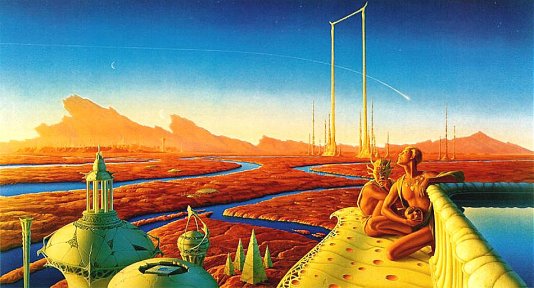
Bradbury's Martian Chronicles
~ © Bantam Books
B. The Atmosphere Factory.
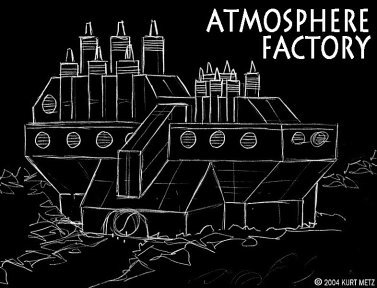
From
the Kurt Metz Animation Project: ERBzine 1350
The origin of the atmosphere factory, which also makes
life possible on Mars, is obscure, but it appears to have been invented
by the Orovars of Horz. We get this tidbit of information from Pan Dan
Chee in the first installment of Llana of Gathol, as he explains
the history of his race to Carter:
“‘They had reached the
ultimate pinnacle of civilization and perfection when the first shadow
of impending fate darkened their horizon – the seas began to recede, the
atmosphere to grow more tenuous. What science had long predicted was coming
to pass – a world was dying.
“‘For ages our cities followed the
receding waters. Straits and bays, canals and lakes dried up. Prosperous
seaports became deserted inland cities. Famine came. Hungry hordes made
war upon the more fortunate. The growing hordes of wild green men overran
what had once been fertile farm land, preying upon all.
“The atmosphere became so tenuous
that it was difficult to breathe. Scientists were working on an atmosphere
plant, but before it was completed and in successful operation all but
a few of the inhabitants of Barsoom had died. Only the hardiest survived
– the green men, the red men, and a few Orovars; then life became merely
a battle for the survival of the fittest.’” (LG/I-4.)
By the time of Carter's advent on the red planet, the atmosphere
factory is fully functional and is off limits as a trophy of war. Carter
and Woola accidentally stumble upon it as they make their way to the canal
that will lead them to Zodanga in A Princess of Mars:
“At daybreak of the fifteenth
day of my search I was overjoyed to see the high trees that denoted the
object of my search. About noon I dragged myself wearily to the portals
of a huge building which covered perhaps four square miles and towered
two hundred feet in the air. It showed no aperture in the mighty walls
other than the tiny door at which I sank exhausted, nor was there any sign
of life about it.
“I could find no bell or other method
of making my presence known to the inmates of the place, unless a small
round hole in the wall near the door was for that purpose. It was of about
the bigness of a lead pencil and thinking that it might be in the nature
of a speaking tube I put my mouth to it and was about to call into it when
a voice issued from it asking whom I might be, where from, and the nature
of my errand.” (PM/20.)
Carter explains his situation to the voice, who is suspicious
because Carter is so different from any other race of men on Barsoom. Carter
tells him he is a friend of the red men and is starving to death.
“Presently the door commenced
to recede before me until it had sunk into the wall fifty feet, and then
it stopped and slid easily to the left, exposing a short, narrow corridor
of concrete, at the further end of which was another door, similar in every
respect to the one I had just passed. No one was in sight, yet immediately
we passed the first door it slid gently into place behind us and receded
rapidly to its original position in the front wall of the building. As
the door had slipped aside I had noted its great thickness, fully twenty
feet, and as it reached its place once more after closing behind us, great
cylindars of steel had dropped from the ceiling behind it and fitted their
lower ends into apertures countersunk in the floor.
“A second and third door receded
before me and slipped to one side as the first, before I reached a large
inner chamber where I found food and drink set out upon a great stone table.
A voice directed me to satisfy my hunger and to feed my calot, and while
I was thus engaged my invisible host put me through a severe and searching
cross-examination.” (PM/20.)
The voice reveals himself at last after Carter passes the
examination:
“Then a door opened at
the far side of the chamber and a strange, dried up, little mummy of a
man came toward me. He wore but a single article of clothing or adornment,
a small collar of gold from which depended upon his chest a great ornament
as large as a dinner plate set solid with huge diamonds, except for the
exact center which was occupied by a strange stone, an inch in diameter,
that scintillated nine different and distinct rays; the seven colors of
our earthly prism and two beautiful rays which, to me, were new and nameless.
I cannot describe them any more than you could describe red to a blind
man. I only know that they were beautiful in the extreme.” (PM/20.)
Because Carter has the ability to read the unguarded Martian
mind with no Martian capable of his reading his own, he learns a lot more
about the atmosphere factory than the old man would have otherwise allowed.
“The building in which
I found myself contained the machinery which produces the artificial atmosphere
which sustains life on Mars. The secret of the entire process hinges on
the use of the ninth ray, one of the beautiful scintillations which I had
noted emanating from the great stone in my host’s diadem.
“This ray is separated from the
other rays of the sun by means of finely adjusted instruments placed upon
the roof of the huge building, three-quarters of which is used for reservoirs
in which the ninth ray is stored. This product is then treated electrically,
or rather certain proportions of refined electrical vibrations are incorporated
with it, and the result is then pumped to the five principal air centers
of the planet where, as it is released, contact with the ether of space
transforms it into atmosphere.
“There is always sufficient reserve
of the ninth ray stored in the great building to maintain the present Martian
atmosphere for a thousand years, and the only fear, as my new friend told
me, was that some accident might befall the pumping apparatus.
“He led me to an inner chamber where
I beheld a battery of twenty radium pumps any one of which was equal to
the task of furnishing all Mars with the atmosphere compound. For eight
hundred years, he told me, he had watched these pumps which are used alternately
a day each at a stretch, or a little over twentyfour and one-half Earth
hours. He has one assistant who divides the watch with him. Half a Martian
year, about three hundred and forty-four of our days, each of these men
spend alone in this huge, isolated plant.” (PM/20)
Carter discovers that every Martian as a child learns the
principles of the manufacture of atmosphere but only two men hold the secret
of ingress into the building. The factory is virtually unassailable with
walls a hundred and fifty feet thick and the roof is guarded from air assault
by a glass covering five feet thick. The only fear is of some demented
person or by an attack by the green men, for all Barsoomians realize that
their very existence hinges on the survival of the factory.
Carter also learns one fact that he is not supposed to
in a moment when the old man lets down his mental guard:
“One curious fact I discovered
as I watched his thoughts was that the outer doors are manipulated by telepathic
means. The locks are so finely adjusted that the doors are released by
the action of a certain combination of thought waves. To experiment with
my new-found toy I thought to surprise him into revealing this combination
and so I asked him in a casual manner how he had managed to unlock the
massive doors for me from the inner chambers of the building. As quick
as a flash there leaped to his mind nine Martian sounds, but as quickly
faded as he answered that this was a secret that he must not divulge.”
(PM/20.)
From then on the old man supects that he has given the secret
away to Carter and resolves to kill Carter while he is sleeping to make
sure the secret stays safe. However, Carter reads the old man's mind and
escapes with Woola using the nine Martian sounds. This knowledge eventually
helps Carter to save the planet when the old man and his assistant mysteriously
die.
As a last desperate act, Carter races from Helium in a
flier to the atmosphere factory:
“An hour before dark the
great walls of the atmosphere plant loomed suddenly before me, and with
a sickening thud, I plunged to the ground before the small door which was
withholding the spark of life from the inhabitants of an entire planet.
“Beside the door a great crew of
men had been laboring to pierce the wall, but they had scarcely scratched
the flint-like surface, and now most of them lay in the last sleep from
which not even air would awaken them.
“Conditions seemed much worse here
than at Helium, and it was with difficulty that I breathed at all. There
were a few men still conscious, and to one of these I spoke.
“‘If I can open these doors is there
a man who can start the engines?’ I asked.
“‘I can,’ he replied, ‘if you open
quickly. I can last but a few moments more. But it is useless, they are
both dead and no one else upon Barsoom knew the secret of these awful locks.
For three days men crazed with fear have surged about this portal in vain
attempts to solve its mystery.’
“I had no time to talk, I was becoming
very weak and it was with difficulty that I controlled my mind at all.
“But, with a final effort, as I
sank weakly to my knees I hurled the nine thought waves at that awful thing
before me. The Martian had crawled to my side and with staring eyes fixed
on the single panel before us we waited in the silence of death.
“Slowly, the mighty door receded
before us. I attempted to rise and follow it but I was too weak.
“‘After it,’ I cried to my companion,
‘and if you reach the pump room turn loose all the pumps. It is the only
chance Barsoom has to exist tomorrow!”
“From where I lay I opened the second
door, and then the third, and as I saw the hope of Barsoom crawling weakly
on hands and knees through the last doorway I sank unconscious upon the
ground.” (PM/27.)
Carter is then astrally projected back to the Arizona cave
where his adventure began and is unable to return to Mars for ten years
to see if the man made it to the pumps.

ANALYSIS

To say that ERB was ahead of his time is cliche. I read
somewhere that H.G. Wells said that he was mad. And no wonder. I remember
when I was in the fifth grade that only about 5% of Americans thought that
intelligent life existed outside of Earth. Anyone who believed we were
not alone in the universe were mocked as believers “in little green men
from Mars.”
I recall dreaming that I would be the first man on the
moon. That was in 1957. Imagine how the Martian series must have appeared
to the average educated reader in 1912 when A Princess of Mars was
first published. And yet it only took twelve years since I dreamed of being
the first man on the moon for Neil Armstrong to beat me to it.
I also have a theory of who killed the caretaker of the
atmosphere plant and his assistant, which I think makes sense as our own
world faces some of the greatest challenges to its water supply and atmosphere.
I think after eight hundred years living in isolation that the old man
became so paranoid that he went mad and decided to take the whole planet
with him in a mass suicide.
I see the same kind of madness today with the disaster
in the Gulf of Mexico and an incredible amount of people actually entertaining
the possibility that the world will come to an end on December 21, 2012.
I don't know about you, but I intend on waking up on December 22, 2012,
with a hangover and a beautiful woman who thought she would go out with
a bang.
Hopefully, there are still some Orovars among us that
will save our lovely paradise from ending up like Barsoom. ERB sure gave
us something to think about.
And there you have it,
ERB's Life-Saving Pumping Stations of Mars: The First
Wonder of Barsoom!


![]()
